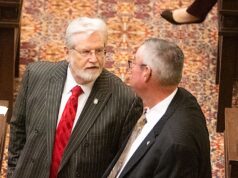
Inside a packed southwest Oklahoma City event center, immigration attorney Michael Brooks thanked volunteers, donors and the voters who told him their personal stories on the campaign trail.
Brooks, a Democrat, became Oklahoma’s newest state-senator-elect Tuesday evening by taking 54.6 percent of the vote over Republican Joe Griffin in SD 44.
Up the turnpike in Tulsa, fellow Democrat Karen Gaddis earned 52.3 percent of Tuesday’s vote to defeat Republican Tressa Nunley.
Those results will boost Democratic numbers in both chambers — 27 in the House and seven in the Senate — and they are also being discussed on social media this morning as evidence of a mild comeback for the party that dominated state politics for 100 years before cratering over the past decade.
Still, such a narrative is probably too broad to draw any certain conclusions about party politics as a whole. Instead, however, let’s look at a few factors that affected Tuesday night’s results.
A fairly perfect storm
Both Gaddis and Brooks won in special elections with low turnout. While 12,804 people cast November 2016 ballots in HD 75, only 2,049 did so Tuesday. And after 10,482 cast November 2014 ballots in SD 44, only 3,619 voted Tuesday. (Interestingly, SD 44 was far and away the lowest-turnout senate district in 2014 races, with 5,000 fewer people voting in Southwest OKC and Canadian County than in any other district.)
As incumbents in 2018, Gaddie and Brooks will have a leg up, assuming they avoid scandal or political faux pas. But in this summer’s special election, they already had a leg up. Their mutual appearances on previous ballots surely helped with name identification.
The two Democrats were also running in seats vacated by Republican politicians who were ousted based on various sexual deviances. Dan Kirby left amid sexual harassment allegations, and Ralph Shortey is facing criminal charges related to soliciting prostitution from a teenage boy.
Lastly, they were also running in municipal areas where voter profiles are turning more progressive-friendly.
In all, those recipes spell a good path forward for Democrats, especially considering future metro-area special elections on the horizon. But those trends mostly exist in a vacuum and probably cannot be extrapolated into 2018 legislative-race predictions.




















